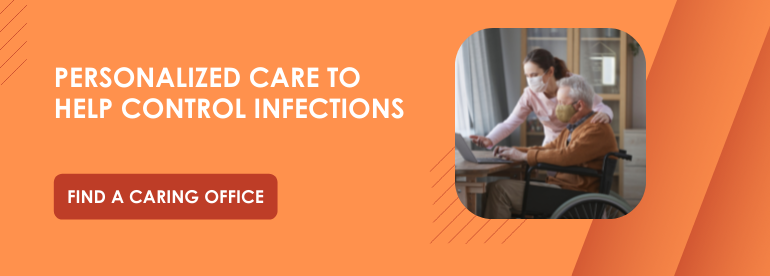Respiratory tract infections (RTIs) are infections in the lungs, throat, airways, or other parts of the body that are involved in breathing. Because these infections affect the same parts of the body, there are some overlapping symptoms — like coughing, sneezing, runny nose, or a sore throat. But these infections can vary in severity and underlying cause. Seniors are especially prone to RTIs because of preexisting conditions, weakened immune systems, and more. Let’s review different types of RTIs so you can be on the lookout for them in your aging loved ones.
Upper RTIs
Upper RTIs affect the sinuses and the throat. These types of RTIs include the common cold, sinus infections, tonsillitis, and laryngitis.
Common Cold
We’ve all experienced the common cold. The sore throat, congestion, and overall crummy feeling. It is a viral infection caused by a number of different types of viruses. The most common, however, are rhinoviruses. The virus is easily spread through contact or even through droplets in the air as someone talks, coughs, or sneezes. Colds are known as the common cold because they are one of the most frequent illnesses we experience. In fact, healthy adults get colds about 2 to 3 times each year.
Most colds clear up on their own within a week or two, and they generally aren’t a cause for concern. You may want to purchase over-the-counter cold medications, decongestants, or pain relievers to help with your symptoms.
Looking to prevent a cold? Check out this post: 5 Ways to Prevent the Common Cold. And if you do catch a cold, try this home remedy.
Sinus Infection
Sinus infections (or sinusitis) are another type of RTI that you may be familiar with. This type of infection is characterized by the swelling of your sinuses. The sinuses are empty cavities within your head that are connected by narrow channels. They make mucus, which eventually drains out of your nose. Usually, the sinuses are empty and just filled with air. But when you have a cold or allergies, the sinuses can become inflamed or blocked, and bacteria has a chance to settle and grow into an infection. You may feel pain or pressure in your forehead, cheeks, or eyes. You might also have a headache or toothache.
Some sinus infections clear up on their own. You can take painkillers and decongestants to help manage symptoms. However, a lingering sinus infection may require prescription medications.
Tonsillitis
Tonsillitis is the inflammation of your tonsils, which are the two oval bumps at the very back of your mouth. The tonsils are actually part of the body’s immune system. They help stop germs from entering the body and they also house a lot of white blood cells, which help kill germs. But this immune response is strongest when you are young. As we age, the role of our tonsils diminishes, making tonsillitis les likely as an adult.
Because the tonsils are one of the body’s first lines of defense, they come into contact with lots of germs and are vulnerable to infection. The most common cause of tonsillitis is the bacteria that causes strep throat. But a virus could also cause tonsillitis. Symptoms of this infection may include a very sore throat, pain while swallowing, bad breath, and fever. But you might also notice white or yellow spots on your tonsils, or they may appear red and swollen.
Tonsillitis can go away on its own within a week or so. However, recurring tonsillitis may require you to have your tonsils removed.
Laryngitis
Laryngitis is an infection in your larynx, or your voice box. Usually, the infection is caused by a virus, but it could also be caused by bacteria or even fungi. It can be the result of the cold or flu. The vocal cords become inflamed, resulting in voice changes, throat pain, or pain when talking or swallowing. And these symptoms usually come on fast.
Like other upper respiratory infections, laryngitis can clear up on its own in a week or two. To help your vocal cords heal, try to limit speaking as much as possible and push fluids. You can also try gargling with salt water. If your symptoms persist, you can always reach out to your doctor for a treatment plan.
Lower RTIs
Lower RTIs affect the airways and the lungs. Lower RTIs tend to be more serious than upper RTIs, and they can last longer. Lower RTIs include bronchitis and pneumonia.
Bronchitis
Bronchitis is an infection of your bronchi, which are the main airways in your lungs. They branch off into each lung and eventually break into smaller airways called bronchioles. The bronchi can become irritated and inflamed as a result of another infection. The body will naturally produce more mucus to get rid of the infection, and you will cough more to expel that mucus. All that coughing and mucus can block the bronchi and irritate them over time. Bronchitis is common after a cold, flu, or even a sore throat.
If you have bronchitis, you may have a wet cough, headache, runny nose, chest pain, and sore throat. Most cases of bronchitis are acute, meaning they only last for a short time. However, some individuals experience chronic bronchitis, which means a productive cough that lasts for 3 months out of the year for 2 years in a row.
Acute bronchitis can clear up on its own, although the symptoms may be unpleasant. But there’s no cure for chronic bronchitis. Talk with your healthcare provider to determine treatment options to manage your symptoms.
Pneumonia
Pneumonia is an infection in the small air sacs (alveoli) within lungs. These air sacs are where the body exchanges carbon dioxide and oxygen. So, if they don’t work properly, you can struggle to get the air you need. As a result, individuals with pneumonia often have shortness of breath, weakness, coughing, or even loss of appetite.
Pneumonia is very common in seniors. In fact, it’s the 5th leading cause of death in seniors. It can be caused by bacteria, viruses, and fungi. Usually, individuals develop pneumonia after another illness, like COVID-19, flu, cold, or other illnesses.
This RTI can be treated with medication. But the treatment plan really depends on the underlying cause of the infection.
Respiratory infections are most common during winter months, when we all spend more time indoors and germs spread more quickly. If you or a loved one has a respiratory infection and needs assistance with tasks of daily living, reach out to a Caring team near you!


